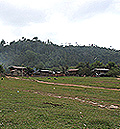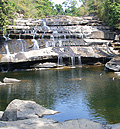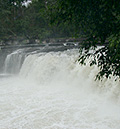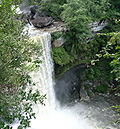|
| New Products Phou khao Kouay |
|
|
|
|
| |
|
 |
Ban Hatkhai - a village with charm
Ban Hatkhai, a small village at the edge of Phou Khao Khouay National Protected Area, is an ideal starting point for staggering trekking tours into the mountainous area along the ‘Nam Mang’ river. This more than 200 years old village in the Province of Bolikhamsay (Thaphabath District) is home to two ethnic groups commonly but incorrectly called “Lao Lum” and “Lao Soung” (about 30%). About 90 families with nearly 600 people are living here. |
| |
|
 |
Phou Khao Khouay
Interesting alternatives to mainstream tourism are currently developed in several parts of Lao PDR. Community – based nature and culture tourism in some of the country’s twenty National Protected Areas ( “NPA”, also know as “NBCA” or “National Biodiversity Conservation Areas” ) is aiming to give visitors a glimpse of the magnificent heritage of the Lao people –without compromising the integrity and rights of the people or the interests of nature conservation. |
| |
|
 |
TAD LEUK: A Brief Introduction and trail Map for Tourists
The most accessible and developed place inside Phou Khao Khouay National Protected Area is the locally well-known Tad Leuk waterfall along the Nam Leuk, one of three major rivers of the reserve. With its 6 Meters height, the waterfall itself is not a spectacular one, but the whole landscape aroud Tad Leuk is simply beautiful and invites for a retreat from the stress of travelling or works in the capital Vientiane, and can easily be visited all year round. |
| |
|
 |
TAD XAY PHA XAY: A Brief Introduction and Trail Map for Tourists
Tadxay and Pha xay are considered to be the most beautiful waterfalls of Phou Khao Khouay National Protected Area (“PKK”). They’re actually two falls within less than a kilometer. The stream Houay Xay has its source in the northern mountains of the park, meanders through dense and relatively untouched evergreen and dry deciduous forest, and finally empties about 2.5 Km north of Ban Hatkhai into the Nam Mang , one of the three major rivers of the Protected Area . |
| |
|
|
|
|
|

